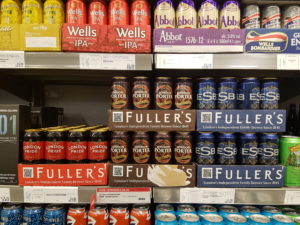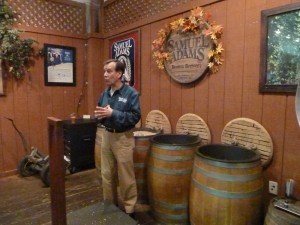Matt Pearson said to me, “take off your glasses.”
It’s a weird request, coming from a guy I barely know, but since we’re in public, I do it.
“Close your eyes and turn around in a circle three times.”
This is not Simon Says, and besides, we’re in the middle of the Beer Cooler at Summerhill. I do it.
“Now, look at the cans in the cooler. Can you name the brands?”
I had been writing the second edition of the Ontario Craft Beer Guide, and Matt, at the time a part owner of Sleeping Giant in Thunder Bay, had come to Toronto. A big fella himself, he liked to spend part of his time when he visited the city walking down Yonge Street. We had met up and gone to look at the all-brand store. I do this with people periodically. I still remember taking Garrett Oliver to the Summerhill Beer Store (now defunct for ritzy condos) and explaining the machinations of the chain.
This comes to mind as I’m standing in the cooler just before the New Year. I’ve popped out for a Gouden Carolus Christmas Ale from Het Anker, and I know I’ve got work coming. I’ve talked the program co-ordinator at George Brown College into some thinking time.
Sierra Nevada has fallen out of the LCBO due, according to Matt, the importer, a value judgment on the cost associated with printing cans for a single export market. Over the last six years the week five lecture for the first course in the Beer Certificate at George Brown has morphed from being a lecture about American Craft Beer to being a lecture I had developed entitled “Is This an IPA?” With Sierra Nevada gone, the narrative throughline is finally dead, and shamefully so just a year after we finally got Timothy Taylor Landlord in the mix which had bolstered it.
It reflects a couple of the problems that I’ve had to face logistically.
Let me run down the list.
Brooklyn Lager? Imported for a while, then brewed under contract by Sleeman and then mothballed in this market. Same deal with Anchor Steam, which came out swinging on draught and then disappeared in this market before it sunk. Genesee Cream Ale? Imported for about eight months in 2018, didn’t make it with the public. Maybe not weird enough. Goose Island Sofie and Matilda? Maybe too weird! We already had things like Honkers, so we can just move on.
Victory Prima Pils? Long player a decade back, but the relisting didn’t last. North Coast Old Rasputin lasted a single season. Smuttynose Robust Porter might have only made it to The Beer Store, not even darkening Elsie’s door before the new facility killed them deader than disco.
Stone Arrogant Bastard? Well, they started making fizzy yellow beer and then Hokkaido came calling for the Beer Jesus. Rogue Dead Guy? Apt moniker. Modern Times Gose sat on the shelves and never seemed to make it off them. Dead. Firestone Walker Lager looked like it had a chance, but it showed up in April 2020 and by the time it was discounted four bucks a year later, it was cardboard. Ballast Point didn’t even send Sculpin. They sent the grapefruit version. Pointless.
Even the ones that exist are unusable. Sam Adams Boston Lager changed its recipe three years back to appeal to younger drinkers. I can only imagine how Jimbo feels without his barrel of Crystal 60. New Belgium Fat Tire sacrificed its entire being to appeal to younger drinkers who didn’t care. Lagunitas IPA? Back when Tony owned the place, not bad. Now? Brewed by Heineken in the Netherlands and doesn’t travel terribly well.
Of the options that remain, Founders’ products are unusable for political reasons, Flying Dog Gonzo is on clearance and not widely available, and if I’m honest, I already teach Miller Lite as a sorbet to cleanse the lawnmower.
There’s Sweetwater IPA, now owned by a cannabis company. A Sam Adams Session IPA, Wicked Easy which shows some promise. Kona Hanalei is not bad, but no one is ever going to claim it’s a bedrock American craft beer. Deschutes Fresh Hazy IPA is pretty good and the Stone Fear Movie Lions Double IPA has been hit or miss depending on the age
We’re provisioning for a class that needs a narrative through line and none of those beers are part of the pantheon. The American Craft Beer narrative, at least as far as Ontario goes, is dead. You might care about it, but you’re going to have to cross a border to see it.
The class is maybe three hours long, and usually features eight to ten beers. I have to get them provisioned for the next three months at the beginning of the semester. Using American IPA has been hit and miss for availability, and in terms of age, what do you get when you crack a nine month old IPA that traveled from California? Devils and dust.
It’s as I’m standing in the fridge, looking at this wide variety of Ontario beers, that I realize I’m going to have to tell a different story when I submit the requisition list later this week. It’s the one I’ve been telling all along.
I’m going to have to tell our story.


Reading your article made me sad while you listed all the fallen soldiers. But what a turnaround, I finished with a smile. Your writings are one of the few I double-click on Jordan. Keep up the good fight!
The amazing thing about it is I had to go back and edit when I remembered Goose Island was a thing. They still have presence in the LCBO, obviously, but eventually you realize that they’re coping with the downturn market like everyone else; releasing hazy IPA to see if it will stick. If I wanted to do that I’d have thrown in Voodoo Ranger (No offense to Wheels, who’s doing a heck of a job with it.)
Sounds like it’ll be an awesome class. Really nice article here: can it be assigned to be read prior to the class? It just sets the scene and context so succinctly – it gives a history without giving the history – so it would work very well as a sort of preamble to the class, I think. In any case, great read.
My classes don’t have any set readings, weirdly. I’m all Tabula Rasa. I’ll recommend books (Randy Mosher’s 2nd edition and Mirella’s Beerology), but I prefer to draw them out.
I don’t view it as teaching them canon. You need more than six weeks to get up to speed with any of that, and the first course is six weeks long. I view it as teaching them how to palate and apply some common sense principles. Some people have more affinity for it than others, but it keeps the material lively. Sometimes we’ll produce an absolute world beater of a taster. I’ll talk about that a little bit, maybe.
Pingback: So You Want To Be A Teacher - Redevelop - St. John's Wort